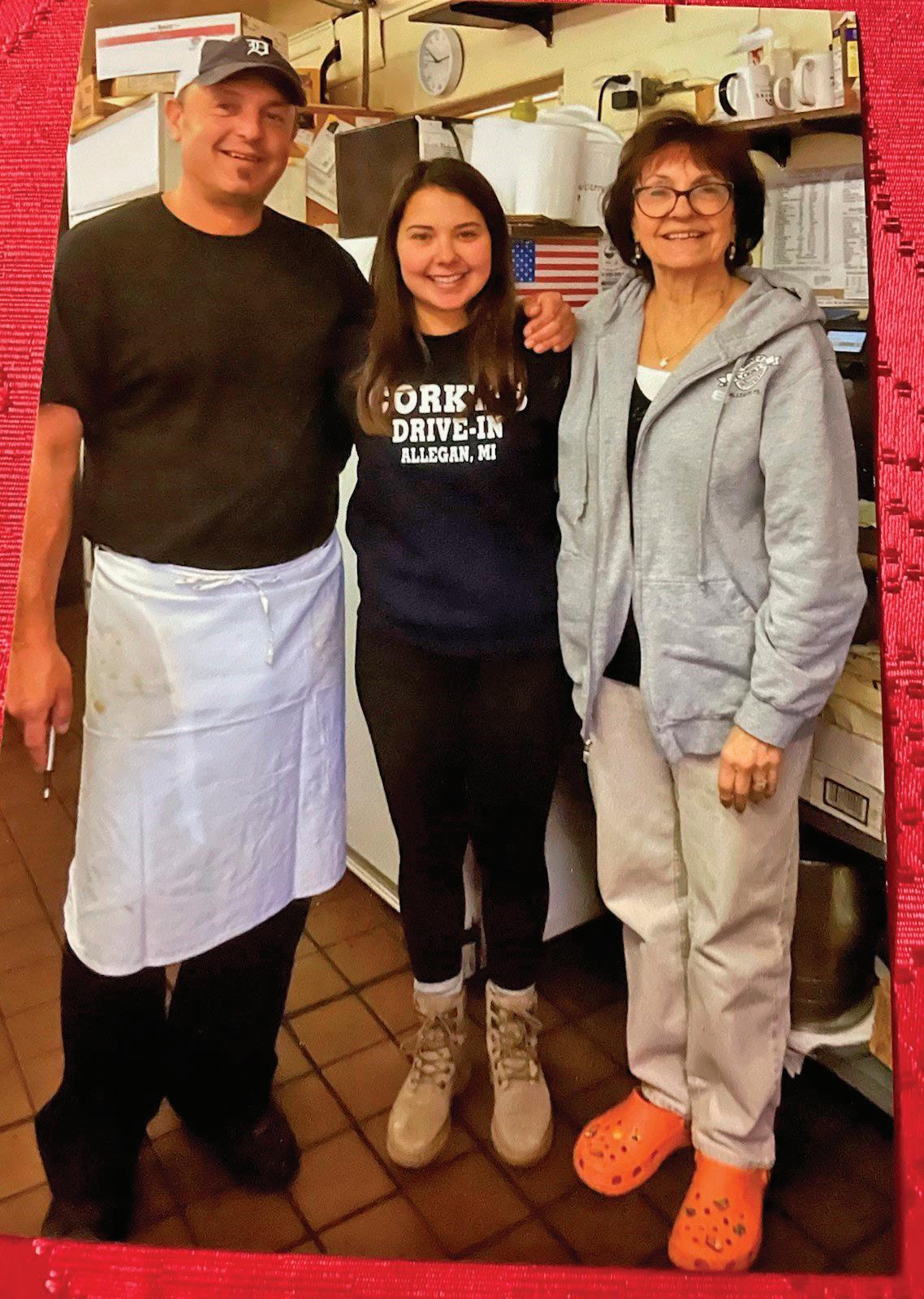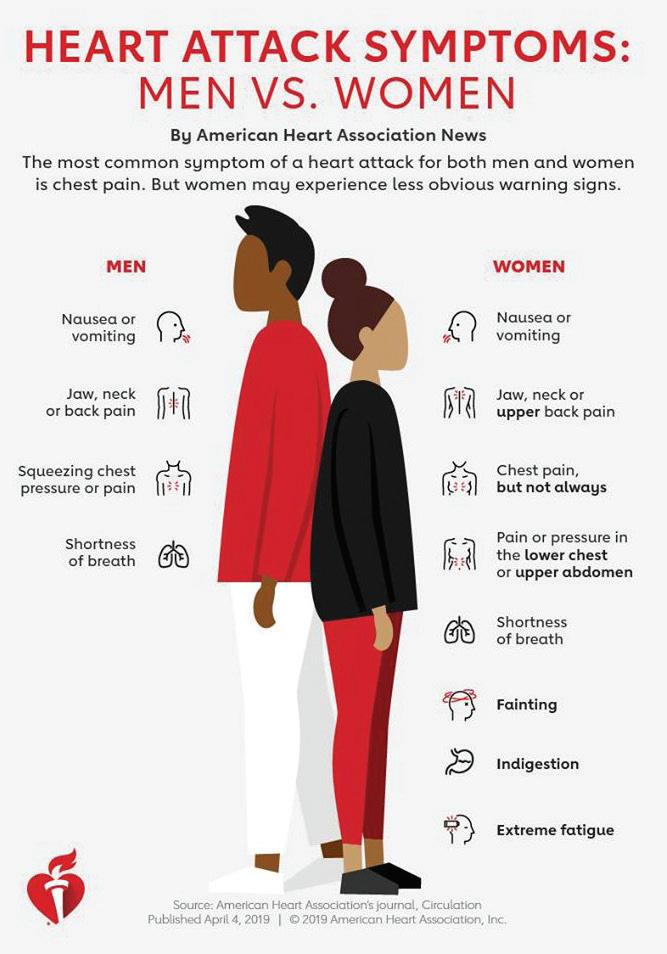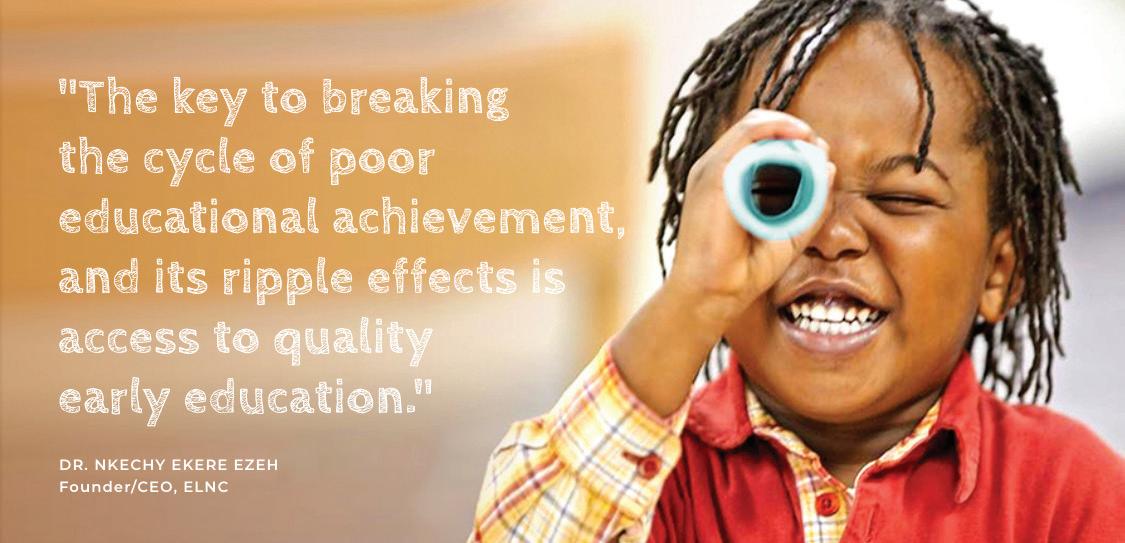
9 minute read
Go Red for Women: Linda Mankin’s Cardiac Story
from Women's LifeStyle magazine - February 2021 - Tiffany Dionne Kelly, "A Lost Girl's Journey to Hope."
American Heat Assocation GO RED FOR WOMEN
Linda Mankin’s Cardiac Story
Advertisement
Linda Mankin injured her knee in 2015, and while getting treatment, she asked the doctor about pain she was having in her jaw. at doctor sent her to a dentist to examine her for TMJ. e pain continued, and they sent her to another medical care provider who treated her with medication.
e jaw pain persisted, and pain became part of her life. Over the next few years she had an EKG; help from a chiropractor; and eventually a neurologist who determined the pain was coming from her spine, pinching her between the C5-and C6. ese vertebrae provide exibility and support to much of the neck and the head. Any treatment or medication only slowed the Mankin’s jaw pain for a few days instead of the months that she expected. In all, she saw eight professionals. Tests indicated her veins looked healthy.
“I was 70 years-old and they told me I had the veins of a 40-year-old,” said Mankin. “ at encouraged me.” Mankin, who works with her family at their business, Corky’s Drive-In in Allegan, found that the pain made it hard for her to work, but she would tilt her head back to ease the pain and continue working.
“If the pain got too bad, I learned to tilt my head back a bit with my jaw up in the air and I would get some relief,” said Mankin. “If I was walking down a ight of stairs, looking down could make the pain worse.”
She underwent spinal surgery and afterward went to a pain management clinic. Medication designed to last months lasted only days before the pain returned.
In March 2019, the jaw and headache pain were so bad that her husband Randy encouraged her to go to the Emergency Room. After a twelve-lead EKG, the sta asked her what she would like to do for further treatment.
“I thought, you better not be telling me I’m having a heart attack!” said Mankin. But further testing revealed three blocked cardiac arteries at 100, 90 and 70 percent.
She had an angioplasty, and there were complications. Repairs were nished in only one artery when they placed her in an induced coma so her body could recover. ree days later she woke to nd her family at her bedside. In May 2019, another repair to an artery and was successful.
Since her recovery, Mankin still works at Corky’s Drive-in, but at a slower pace. She works hard to lower work-related stress.
Jaw pain is one of the cardiac indicators highlighted by the American Heart Association’s Go Red for Women campaign. (See infographic.) Chest pain or discomfort is caused when your heart muscle doesn’t get enough oxygen-rich blood. It may feel like pressure or squeezing in your chest. e discomfort also can occur in your shoulders, arms, neck, jaw, or back. Angina pain may even feel like indigestion. In Mankin’s case, it didn’t show as a heart condition in early medical tests.
What is Go Red for Women? In 2004, the American Heart Association faced a challenge. Cardiovascular disease claimed the lives of nearly 500,000 American women each year, yet women were not paying attention. In fact, many even dismissed it as an older man’s disease. To dispel the myths and raise awareness of heart disease & stroke as the number one killer of women, the American Heart Association created Go Red For Women, a passionate, social initiative designed to empower women to take charge of their heart health.
e campaign has worked to educate our community that a heart condition in a woman might not look like it does in a man. As with men, women’s most common heart attack symptom is chest pain or discomfort, but women are somewhat more likely than men to experience some other common symptoms, particularly shortness of breath, nausea/vomiting, and back or jaw pain.
In West Michigan, the American Heart Association has been working with the medical community and area women to spread the message that heart disease is not just a man’s disease and that nearly 80 percent of cardiac events can be prevented with diet, exercise and healthy living.
is year the association will host the Grand Rapids Go Red for Women digital experience on February 11 from noon until 2 p.m. Chaired locally by Kellie Norton, a director with Blue Cross Blue Shield of Michigan, the event will highlight area survivors, have an medical moment, and have a silent auction.
Sponsored nationally by CVS Health and locally sponsored by Spectrum Health, other sponsors include Blue Cross Blue Shield of Michigan, Meijer, Priority Health. Metro Health and the Metro Health Foundation are the Have Faith in Heart Sponsors. Media sponsors include Mix 95.7, e River 100.5, Women’s Lifestyle Magazine and WOTV4 Women. To register, go to Heart.org/GrandRapidsGoRed. ere is no charge to attend this year.
National Wear Red Day, part of the Go Red for Women initiative, is Friday, February 5, and everyone is encouraged to wear a touch of red that day. We want to see you in red! Post your photos to social media with the hashtag #GrandRapidsGoRed.
What do I do if I’m having a heart attack?

If you experience any of these signs or symptoms:
• Dial 911 immediately, follow the
operator’s instructions and get to a hospital right away.
• Don’t drive yourself to the
hospital.
• Try to stay as calm as
possible and take deep, slow breaths while you wait for the emergency responders.
Women who think they’re healthy often misread the symptoms of a heart attack because they don’t think it could happen to them. That’s why it’s crucial to learn about heart attack, know your numbers and live heart-healthy.
ey are sometimes called “rescue dogs”, but we truly believe that we are the ones being rescued by them.

We want to hear your dog rescue story.
From abuse and neglect, to hope and happiness. dogs@womenslifestyle.com


Health Care for Black Women:
Why It’s Different
by Akansha Das
In her victory speech on November 7th, Vice-President elect Kamala Harris remarked that often the most overlooked women in women’s fi ght for equality and part of “backbone of our democracy” are Black women. Sadly, this theme is not isolated to politics. Extrapolating out, this week we wanted to shine a light on the history of gynecology and women’s health in America in regards to Black women and acknowledge the historical factors that make their current relationship with the medical establishment so tumultuous.
The roots of the anti-Blackness within the medical community date back to the era of slavery according to University of Nebraska professor Deirdre Cooper Owens (and author of the Medical Bondage, a book about the history and sociology of gynecology). Dr. John Sims is well-known within the medical community for his pioneering of the vesicovaginal fi stulae in the 1840s, which garnered him the sole bearer of the title “father of gynecology.” Yet the history books don’t note that Dr. Sims heavily depended on Black enslaved women as both patients and nurses/ surgical assistants and unfortunately did’t grant them with the well-deserved titles of “mothers of gynecology”. Undergoing the excruciating pain of gynecological procedures, the ten or so Black women crucial to the perfection of the vesico-vaginal fi stulae often had to support and help operate on women undergoing the same procedures (without consent) that they went through. This was all in addition to their daily slave duties.
Along with the injustice of the situation, this practice perpetuated the idea that the bodies of Black women were invincible and “immune to pain.” Studies have shown that as recently as 2016, 40% of medical trainees believed that “black people’s skin is thicker than white people’s” and that Black women are 22% less likely to receive pain medications than white patients because of the wholly inaccurate belief that the nerve endings of Black women are less sensitive than those of White women.
We can’t discuss healthcare and Black women without talking about the staggering and devastating disparity in maternal and fetal death rates between Black women and their counterparts. In Grand Rapids alone, a Black baby is twice as likely to die than a White baby as of 2017 and in the state of Michigan, Black mothers are three times more likely to die from childbirth than their White counterparts. In some parts of the country - especially metropolitan areas - the disparity can be four to fi ve times higher for Black women. This stark difference
can not be entirely explained by education level (in fact White uneducated women have lower maternal mortality rates than Black, educated women), prenatal care, weight, genetic correlations, or even environmental factors like diet, smoking, or alcohol use; thus far, the only statistically signifi cant contributor to the Black maternal death rate is the cortisol effect.
This states that the day-to-day stresses that Black women face (and unfortunately become their norm) from small microaggressions to explicit acts of discrimination, to the stress of picking which battles they want to fi ght, to even their statistical likelihood of being primary breadwinners all heighten their levels of the stress hormone cortisol in their bodies. The heightened levels of cortisol is normal for all women around pregnancy but its heightened nature in Black women throughout their lifetime can lead to infl ammation that can restrict blood fl ow to the placenta and stunt infant growth. Higher cortisol levels can also trigger preterm labor which can disadvantage Black babies with a lower birth weight from the very beginning of their lives and contributes to the two-fold increase in low birth weight among Black infants.
We recognize the tragic juxtaposition in Black women being the backbone of the medical system and yet the ones least benefi ted by it. As we strive to create a future where this health disparity no longer exists, we must remember that in the end it is racism, not race, that is the root of the problem. The complete diminishing of this gap will require reforms in housing, the criminal-justice system, education, environmental injustice and even the implicit biases within the medical establishment. While we recognize these changes won’t happen overnight, we can continue to promote an anti-racist culture in every facet of society. After all, it’s time. We have the data and certainly the means to do so. There is no good reason not to change and improve our systems.

Akansha Das, Premed student volunteer with Women’s Health Collective
Nisha McKenzie PA-C
630 Kenmoor Ave. Ste 103 | Grand Rapids, MI 49546 | 616.600.4950 | info@whcollective.com
Read more local stories online


womenslifestyle.com
www.grandrapids.org

No One GROWs It Alone
Kent County Business Owners, GROW's ReStart Kent working capital loan is available directly to those impacted by COVID-19 to help your business stay afloat.
Learn more and view all loan details at www.growbusiness.org or call us today 616-458-3404.

Get Involved with ELNC at:
(616) 608-0754 info@elncgr.org




